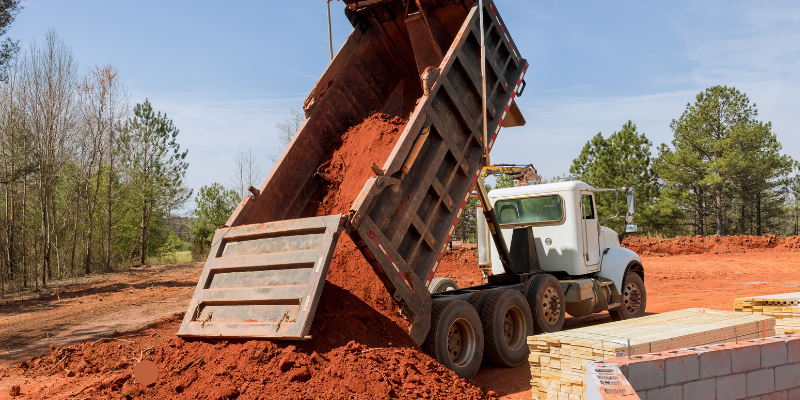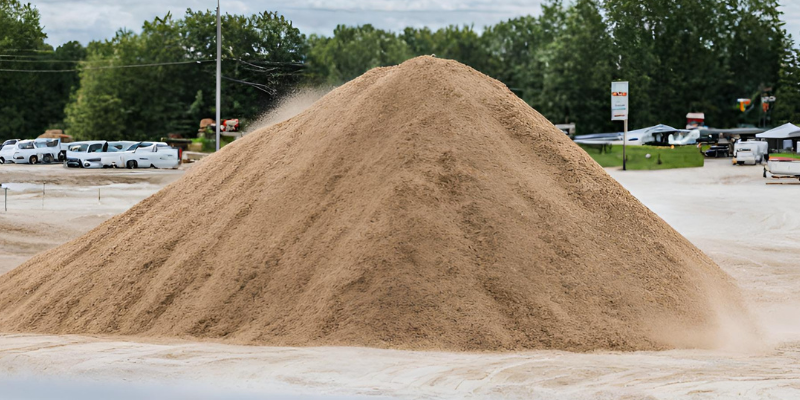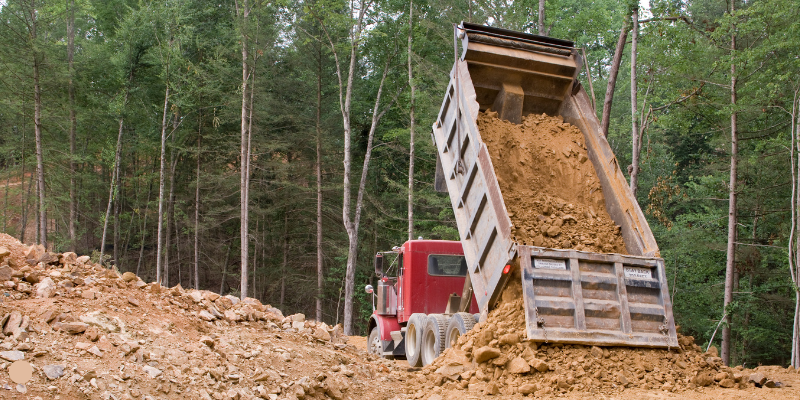When it comes to modern construction, the importance of aggregate materials cannot be overstated.
Table of Contents
ToggleFrom building structural integrity to building the foundation for roadways, aggregate material for construction is the backbone of any successful project.
In this guide, we will delve into the world of construction aggregate, exploring its various uses, the challenges in sourcing it, and the future of its application in construction projects.

The Backbone of Modern Construction: Understanding Aggregate Materials
In the realm of modern construction, the significance of aggregate materials is both foundational and transformative.
These materials, a diverse collection encompassing sand, gravel, crushed stone, and beyond, not only provide the structural integrity vital to our built environment but also serve as a testament to the ingenuity and resilience of the construction industry.
The myriad types of aggregate, each with its unique properties and applications, offer a palette from which the most enduring and aesthetically pleasing structures are crafted.
The journey into understanding aggregate materials begins with an appreciation of their inherent qualities.
Sand, with its fine granularity, is pivotal in creating the perfect concrete mix, offering the smoothness and consistency required for both strength and finish.
Gravel, with its varied sizes and shapes, introduces an element of drainage and support, making it indispensable in everything from road construction to landscaping.
Crushed stone, the cornerstone of aggregate, provides the bulk and strength necessary for the heavy lifting involved in the construction of buildings and highways.
This exploration of aggregate materials is not merely academic but practical.
Recognizing the specific characteristics and best uses of each type of aggregate material enables contractors to tailor their choices to the demands of each project, ensuring not only structural integrity but also efficiency and cost-effectiveness.
The strategic selection of aggregates is a craft in itself, one that underscores the balance between engineering demands and the aesthetic vision that characterizes the most successful construction projects.
The role of aggregate materials extends beyond mere functionality.
They are the unsung heroes of sustainability in construction, offering pathways to reducing the environmental footprint of new projects through their local availability and potential for recycling.
In this sense, understanding aggregate materials is not only about grasping their physical properties but also about appreciating their contribution to the environmental and economic sustainability of construction practices.
Navigating the Challenges of Sourcing Quality Aggregate Materials
In the complex arena of modern construction, the quest for high-quality aggregate materials presents a formidable challenge to contractors.
The procurement of these essential components often becomes a test of one’s ability to balance quality, cost, and reliability, with the integrity of entire projects hanging in the balance.
The endeavor to secure the best aggregates demands not only a discerning eye for superior materials but also a robust network of dependable suppliers.
The journey to sourcing premium aggregate materials begins with an in-depth understanding of the specific needs of each project.
Different constructions have varied demands, making it crucial for contractors to meticulously assess the type, quality, and quantity of aggregates required.
This precision in selection ensures that the structural and aesthetic requirements of the project are met with unwavering accuracy.
However, the path to acquiring such materials is often riddled with obstacles, from fluctuations in availability to unpredictable variability in material quality.
Herein lies the importance of forging and nurturing relationships with reputable suppliers.
A trusted supplier does not merely provide materials; they become a pivotal partner in the project’s success, offering consistency, timely delivery, and often invaluable expertise on material suitability and innovations.
To further solidify this partnership, contractors are encouraged to engage in proactive quality checks.
Visiting supply sites, participating in material testing, and staying informed on the provenance of the aggregates can significantly mitigate risks associated with subpar materials.
This vigilant approach not only safeguards the project’s integrity but also enhances the contractor’s reputation for quality and reliability.
Navigating the complexities of sourcing high-quality aggregate materials, therefore, requires a strategic and informed approach.
It is a delicate dance of leveraging relationships, understanding the nuanced needs of each project, and maintaining a steadfast commitment to quality.
In this way, contractors not only overcome the challenges of sourcing but also turn them into opportunities for showcasing their dedication to excellence in construction.
The Role of Aggregate Materials in Sustainable Construction Practices
In an era where sustainability is not just a preference but a mandate, aggregate materials emerge as champions of eco-friendly construction methodologies.
The strategic use of these materials is a testament to the construction industry’s commitment to reducing its environmental footprint while maintaining the integrity and quality of its projects.
Aggregate materials, by their nature, lend themselves to sustainable practices in several compelling ways.
Firstly, the local sourcing of aggregates significantly diminishes the environmental impact associated with transportation.
This practice not only supports local economies but also ensures a lower carbon output, a critical consideration in today’s eco-conscious market.
The proximity of these materials also means a reduction in project lead times, providing an elegant solution to the twin challenges of efficiency and environmental responsibility.
Moreover, the realm of aggregate materials is witnessing a transformative shift towards the incorporation of recycled aggregates.
This shift not only underscores the industry’s innovative approach to sustainability but also highlights its adaptability.
By reusing materials from demolition and construction waste, the industry contributes to a circular economy, minimizing waste and conserving natural resources in a manner that was once thought improbable.
Additionally, the application of aggregates in permeable pavement solutions showcases another dimension of their role in sustainable construction.
These applications support effective water management, reducing runoff and promoting natural water filtration, further affirming the multifaceted contributions of aggregate materials to environmental stewardship.
The symbiotic relationship between aggregate materials and sustainable construction practices is both profound and promising.
It reflects a deliberate move towards embracing materials and methodologies that not only meet the technical and aesthetic demands of modern construction but also align with the global imperative for sustainability.
In this context, aggregate materials are not just the foundation of construction projects; they are the building blocks of a more sustainable future.

Technological Innovations Enhancing Aggregate Material Usage
The landscape of construction is undergoing a remarkable transformation, driven by a wave of technological innovations that are reshaping the use of aggregate materials.
In this dynamic environment, contractors are equipped with an arsenal of tools that elevate the precision, efficiency, and sustainability of construction projects.
One of the most significant advancements is the advent of cutting-edge software solutions designed for meticulous material testing and analysis.
These digital platforms offer unprecedented insights into the properties of aggregate materials, enabling contractors to make informed decisions based on the specific demands of their projects.
This level of analysis ensures that the chosen materials perfectly align with the structural requirements and sustainability goals, minimizing waste and optimizing performance.
Similarly, the development of innovative equipment for material processing and handling marks another leap forward.
These technologies streamline the preparation and integration of aggregate materials, from crushing and sorting to mixing and application.
Enhanced processing equipment not only speeds up project timelines but also improves the quality of the final product, ensuring that structures are both durable and aesthetically pleasing.
Furthermore, the integration of automation and robotics in the handling of aggregate materials represents a frontier of efficiency.
Automated systems and drones for material transport and placement are revolutionizing site operations, reducing labor costs, and enhancing safety.
The precision offered by these technologies minimizes errors and material wastage, further reinforcing the commitment to sustainable construction practices.
The symbiosis between technological innovation and aggregate materials is charting a new course for the construction industry.
By embracing these advancements, contractors are not only enhancing their operational capabilities but are also stepping into a future where projects are delivered with greater precision, efficiency, and environmental consideration.
Best Practices for Managing Large Projects with Aggregate Materials
Efficiently orchestrating large-scale construction projects that leverage aggregate materials necessitates a harmonious blend of strategic foresight and meticulous execution.
The cornerstone of success lies in the development of a comprehensive project blueprint, a document that not only delineates the scope and timeline but also anticipates potential challenges in the sourcing and application of aggregate materials.
This blueprint should serve as a living document, adaptable to the evolving dynamics of the project and responsive to unforeseen contingencies.
Key to the management of such projects is the establishment of robust communication channels.
These channels ensure a seamless flow of information between contractors, suppliers, and on-site teams, facilitating real-time problem-solving and decision-making.
The agility afforded by effective communication cannot be understated; it is the lifeline that sustains project momentum and aligns the collective efforts of all stakeholders toward a common goal.
Quality control occupies a pivotal role in managing large projects, where the scale amplifies the impact of material variances.
Implementing rigorous testing protocols for aggregate materials at different stages of the project—from procurement to application—ensures that every batch meets the specified standards of quality and consistency.
This vigilance is essential, as it directly influences the structural integrity and longevity of the construction.
Furthermore, successful project management involves a strategic partnership with construction material suppliers.
This relationship transcends mere transactions, evolving into a collaborative engagement where suppliers are looped into the project’s vision and challenges.
Such partnerships can yield insights into innovative material solutions and logistical efficiencies, thereby enhancing the overall project outcome.
Embracing these best practices equips contractors with the tools necessary to navigate the complexities of large-scale projects.
By fostering a culture of proactive planning, open communication, stringent quality control, and collaborative supplier relationships, contractors can elevate their project management prowess, ensuring the successful realization of their construction endeavors with aggregate materials.
Ensuring Compliance and Quality Control in Aggregate Material Usage
In the fast-paced world of modern construction, adherence to regulatory standards and quality control protocols is paramount, especially when it comes to the use of aggregate materials.
These guidelines are not merely bureaucratic hurdles but are designed to safeguard the integrity, safety, and longevity of construction projects.
Contractors find themselves at the nexus of innovation and regulation, tasked with the challenge of navigating the complex landscape of industry standards while maintaining the high-quality standards that define their projects.
The journey towards ensuring compliance and managing quality control begins with a thorough understanding of the relevant regulations that govern the use of aggregate materials.
This includes local, state, and federal guidelines, each with its own set of requirements tailored to different aspects of construction. Mastery of these regulations is the first step in mitigating potential risks associated with non-compliance, such as project delays, legal ramifications, and compromised structural integrity.
Quality control, on the other hand, demands a proactive and meticulous approach.
From the initial stages of material selection to the final phases of application, every step requires rigorous testing and inspection to ensure that the aggregate materials meet or exceed the project’s specifications.
This vigilant oversight extends beyond the materials themselves to encompass the methods of their application, ensuring that every aspect of their usage aligns with best construction practices.
Embracing these responsibilities, contractors elevate their projects beyond mere structural accomplishments.
They champion a culture of excellence, where compliance and quality control are not seen as obstacles but as cornerstones of success in the modern construction landscape.

The Future of Aggregate Materials in Construction
Looking forward, the significance of aggregate materials in the construction domain is poised to reach unprecedented heights.
As we steer towards an era where ecological responsibility, technological advancement, and operational efficiency become the guiding stars, these fundamental resources will undoubtedly play a pivotal role.
Innovations in recycling processes and the development of high-performance aggregates are set to redefine their application, enhancing both the sustainability and the structural integrity of projects.
The exploration of alternative aggregates, born from industrial by-products and synthetic materials, opens new avenues for environmental stewardship and resource conservation.
Simultaneously, the integration of digital technologies for precise material analysis and optimization promises to elevate the strategic use of aggregates, ensuring projects not only meet but exceed the aspirations of tomorrow’s world.
In essence, aggregate materials are not merely maintaining their relevance; they are evolving to become the cornerstone of future-forward construction practices, heralding a new chapter of innovation and sustainability in the industry.

